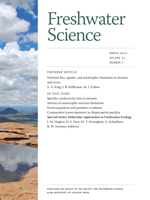Benthic macroinvertebrate community composition is used to assess wetland and stream condition and to help differentiate the effects of stressors among sites. Deoxyribonucleic acid (DNA) barcoding has been promoted as a way to increase taxonomic resolution and, thereby, to increase the sensitivity of bioassessment metrics. We compared the ability of several commonly used bioassessment metrics calculated with data derived from morphology and from DNA barcoding to detect differences in stream condition of 6 paired sites in southern California with relatively subtle impacts to habitat. At each site, we sampled an upstream (reference) reach and a downstream (impact) reach with armored stream banks. We counted and identified ∼600 organisms/ sample based on morphology (generally to species, but to genus for midges). We then extracted mitochondrial (mt)DNA from each individual and sequenced the ∼658-base pair (bp) barcoding region of the cytochrome c oxidase subunit I (COI) gene. Most (91%) organisms yielded sequences >350 bp in length, but high failure rates for all taxa collected from 1 stream required that we exclude it from analysis. Sixteen metrics calculated with morphological data showed subtle but not significant differences in community composition between armored and unarmored reaches. The statistical power of 10 of the 16 metrics was substantially higher when calculated with DNA than with morphological data, and we were able to discern differences between armored and unarmored reaches with the DNA data. These differences were associated with increased taxonomic richness detected for midges, mayflies, noninsects, caddisflies, and black flies when DNA data were used. Our results suggest that identifications based on DNA barcoding have the potential to improve power to detect small changes in stream condition.
BioOne.org will be down briefly for maintenance on 17 December 2024 between 18:00-22:00 Pacific Time US. We apologize for any inconvenience.
How to translate text using browser tools
12 December 2013
Does DNA Barcoding Improve Performance of Traditional Stream Bioassessment Metrics?
Eric D. Stein,
Bryan P. White,
Raphael D. Mazor,
John K. Jackson,
Juliann M. Battle,
Peter E. Miller,
Erik M. Pilgrim,
Bernard W. Sweeney
ACCESS THE FULL ARTICLE
It is not available for individual sale.
This article is only available to subscribers.
It is not available for individual sale.
It is not available for individual sale.

Freshwater Science
Vol. 33 • No. 1
March 2014
Vol. 33 • No. 1
March 2014
bioassessment
DNA barcoding
metric evaluation
streambank armoring
stressor-response




